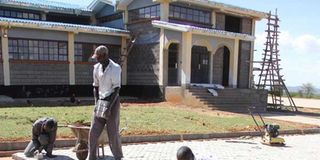Abattoir tipped to transform the lives of the Pokot

Workers put finishing touches at Tukumo Kenya Meat Commission slaughterhouse in West Pokot County. The abattoir, started under the Economic Stimulus Programme will also serve the larger western Kenya. PHOTO | JARED NYATAYA
What you need to know:
- The government set aside Sh1.5 billion for the five abattoirs, which are expected to supply 40 per cent of the country’s demand for beef and mutton
- The county government further says it intends to import fast maturing grass seeds to be dispersed to different parts of the county to boost livestock numbers
A much-touted abattoir that is expected to transform the economic prospects of the livestock-rich West Pokot County is expected to begin operations in the next three months.
Construction site manager Jackson Kimuyu says the first phase, comprising the slaughter structure, animal dens, lagoons and other minor facilities, were ninety percent complete.
The project is one in the Economic Stimulus Programme initiated by the Kibaki administration in 2012 for Arid and Semi-Arid Lands to benefit livestock keepers, especially pastoralist communities.
Slaughterhouses under this programme are also being set up in Wajir, Isiolo, Garissa and Lokichoggio.
The government set aside Sh1.5 billion for the five abattoirs, which are expected to supply 40 per cent of the country’s demand for beef and mutton.
According to County Committee Executive in charge of Livestock and Fisheries, Josiah Cheruiyot, the county and nearby areas are set to benefit from the project both directly and indirectly.
“As a direct benefit, the abattoir will provide employment for about 1,200 of our youth, while others will get the chance to establish markets for the sale of meat,” said Mr Cheruiyot.
The slaughterhouse is also expected to open up the county to markets in neighbouring countries, including Uganda.
“Investment opportunities in areas of meat canning, and the hotel and hospitality industry are expected to spur economic growth,” said Mr Cheruiyot.
The county boasts a tannery near the junction at Tukumo (the location of the slaughterhouse) and will be among the beneficiaries of the abattoir. Activities at the tannery are low due as supply of skins and hides is sporadic.
In efforts to curb cattle rustling, designated sale yards in every market will be supervised by chiefs, veterinary officers and appointed representatives who will verify the health of the animals, ascertain ownership and monitor prices.
“Owners of animals from distant locations will be required to present movement permits, and health certificates from vets,” said Mr Cheruiyot.
BOOST FARMERS' INCOMES
The county government further says it intends to import fast maturing grass seeds to be dispersed to different parts of the county to boost livestock numbers.
The slaughterhouse is expected to boost farmers’ incomes by cutting the costs of transport that have been translating to lower prices at the farm.
So upbeat are residents that they regularly visit Tukumo to check on the progress of the project. “The completion of the facility will certainly transform the fortunes of many people,” said Milcah Chelang’at, a casual labourer.
Margaret Chepkemoi, a Form Four leaver whose dream of being a lawyer was thwarted by lack of school fees, says the creation of a market for livestock will be serve her well as she and her siblings will have a chance to go back to school.
“For a long time, we have been exploited by brokers, but that is going to change,” said Ms Chepkemoi.
Most youth work as casual labourers at the facility, and are optimistic they will secure jobs when the abattoir becomes operational.
Says 24-year-old Milcah Chelang’at: “I’m glad the youth are making some money out of this. I am saving to fund my career after my stint here. I want to work with the abattoir when it is commissioned.”




